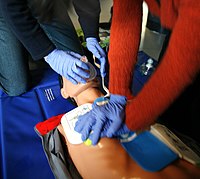
Photo from wikipedia
Introduction This study aimed to compare the results of professional technical and anthropometric anamnesis data with the transmission of external chest compressions performed by military firefighters at different execution times.… Click to show full abstract
Introduction This study aimed to compare the results of professional technical and anthropometric anamnesis data with the transmission of external chest compressions performed by military firefighters at different execution times. Objective The objective was to evaluate the performance and perceived effort of the sequence of external chest compressions performed in two minutes, as well as the evolution of the technique over time. Materials and Methods This was a descriptive, correlational study involving adult firefighters who were members of a specific firefighter group, comprising a population of 105 individuals with a voluntary sample of 44 participants. The study used a Bayesian statistical approach to provide probabilistic expressions. Results The participants had an average work experience of 17 years, an average age of 38.6 years, an average weight of 81.48 kilograms, an average height of 176 centimeters, and an average of 2.5 qualifications. The results indicated that the firefighters performed external chest compressions with excellent technique and a moderate level of perceived effort in a two-minute evaluation. The evaluation of the evolution of the technique over time showed that the participants were able to maintain high-quality compressions for an average of 6 minutes, with a maximum of 20 uninterrupted minutes. Conclusion The study underscores the critical role of professional firefighters in performing and maintaining high-quality external chest compressions, which has the potential to reduce morbidity and mortality in cases of cardiorespiratory arrest.
Journal Title: Emergency Medicine International
Year Published: 2023
Link to full text (if available)
Share on Social Media: Sign Up to like & get
recommendations!